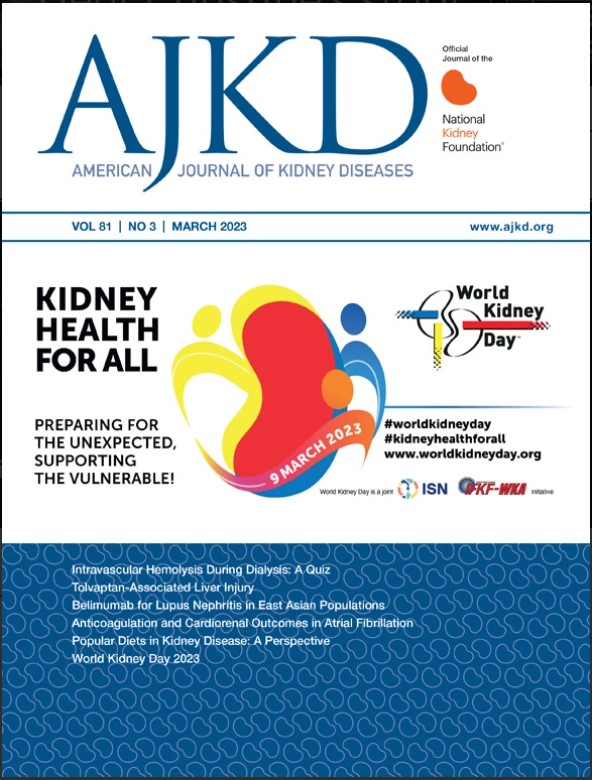慢性肾功能不全队列研究:慢性肾功能不全患者冠状动脉钙化进展与临床事件风险
IF 9.4
1区 医学
Q1 UROLOGY & NEPHROLOGY
引用次数: 0
摘要
理由和目标:与普通人群相比,慢性肾脏病(CKD)患者的冠状动脉钙化(CAC)进展迅速。我们研究了慢性肾脏病成人患者的冠状动脉钙化进展与更高的动脉粥样硬化性心血管疾病(CVD)、充血性心力衰竭和全因死亡率之间的关联:前瞻性队列研究:慢性肾功能不全队列(CRIC)研究中的1310名参与者,他们至少接受过一次CAC扫描,既往无心血管疾病史,并观察或推算出CAC随时间变化的数据:观察到的或估算的 CAC 进展,在基线扫描中 CAC 为零的参与者中被归类为事件性 CAC,或在基线扫描显示 CAC 且每年 CAC 增加≥50 阿加特斯通单位时被归类为进展性 CAC:动脉粥样硬化性心血管疾病(心肌梗死或中风)、充血性心力衰竭和全因死亡率:分析方法:特定病因的 Cox 比例危险回归,根据基线时是否存在 CAC 进行分层:结果:共纳入了 545 名基线时无 CAC 的参与者和 765 名有 CAC 的参与者。在两次CAC评估之间的平均3.3年中,177名(32.5%)无基线CAC的参与者出现了CAC事件,而270名(35.3%)有基线CAC的参与者的CAC每年增加≥50阿加斯顿单位。经多变量调整后,事件性 CAC 与动脉粥样硬化性心血管疾病发病率增加 2.42 倍(95% 置信区间 [CI]:1.23-4.79)和全因死亡率增加 1.82 倍(95% 置信区间:1.03-3.22)有关。进行性 CAC(每年≥50 个单位)与动脉粥样硬化性心血管疾病无关(危险比 [HR]:1.42;95% CI:0.85-2.35),但与全因死亡率增加 1.73 倍有关(95% CI:1.31-2.28)。渐进性CAC与心力衰竭事件无关:局限性:残留混杂因素和某些结果的统计能力有限:结论:在患有慢性肾脏病2-4期的成年人中,CAC在平均3.3年内的进展与较高的动脉粥样硬化性心血管疾病风险和全因死亡率有关。基线时无CAC的参与者的相关性最强。本文章由计算机程序翻译,如有差异,请以英文原文为准。

Progression of Coronary Artery Calcification and Risk of Clinical Events in CKD: The Chronic Renal Insufficiency Cohort Study
Rationale & Objective
Coronary artery calcification (CAC) progresses rapidly in people with chronic kidney disease (CKD) compared with the general population. We studied the association between CAC progression and higher risks of atherosclerotic cardiovascular disease (CVD), congestive heart failure, and all-cause mortality among adults with CKD.
Study Design
Prospective cohort study.
Setting & Participants
1,310 participants in the Chronic Renal Insufficiency Cohort (CRIC) Study who had at least 1 CAC scan with no prior history of CVD and with observed or imputed data on changes in CAC over time.
Exposure
Observed or imputed CAC progression, categorized as incident CAC among participants with 0 CAC on the baseline scan or progressive CAC when the baseline scan demonstrated CAC and there was an increase in CAC ≥50 Agatston units per year.
Outcome
Atherosclerotic CVD (myocardial infarction or stroke), congestive heart failure, and all-cause mortality.
Analytical Approach
Cause-specific Cox proportional hazards regression, stratified by presence of CAC at baseline.
Results
A total of 545 participants without and 765 with prevalent CAC at baseline were included. During a mean 3.3 years between CAC assessments, 177 participants (32.5%) without baseline CAC developed incident CAC while 270 participants (35.3%) with baseline CAC developed a ≥50 Agatston units per year increase in CAC. After multivariable adjustment, incident CAC was associated with 2.42-fold higher rate of atherosclerotic CVD (95% CI, 1.23-4.79) and 1.82-fold higher rate of all-cause mortality (95% CI, 1.03-3.22). Progressive CAC (≥50 units per year) was not associated with atherosclerotic CVD (HR, 1.42 [95% CI, 0.85-2.35]) but was associated with a 1.73-fold higher rate of all-cause mortality (95% CI, 1.31-2.28). Progressive CAC was not associated with incident heart failure.
Limitations
Residual confounding and limited statistical power for some outcomes.
Conclusions
Among adults with CKD stages 2-4, CAC progression over a mean 3.3 years was associated with higher risk of atherosclerotic CVD and all-cause mortality. The associations were strongest among participants without CAC at baseline.
Plain-Language Summary
Prior research has shown that coronary artery calcification (CAC) is a marker of higher risk of heart disease and death. Less is known about how changes in CAC over time might affect risk, particularly among patients with kidney disease. In this study, participants with chronic kidney disease who developed CAC or had worsening CAC over time showed higher rates of heart attack, stroke, and death than those who did not develop CAC. These findings support the need for further research on longitudinal changes in CAC as a possible aid to establishing prognosis among patients with kidney disease and to inform treatment.
求助全文
通过发布文献求助,成功后即可免费获取论文全文。
去求助
来源期刊

American Journal of Kidney Diseases
医学-泌尿学与肾脏学
CiteScore
20.40
自引率
2.30%
发文量
732
审稿时长
3-8 weeks
期刊介绍:
The American Journal of Kidney Diseases (AJKD), the National Kidney Foundation's official journal, is globally recognized for its leadership in clinical nephrology content. Monthly, AJKD publishes original investigations on kidney diseases, hypertension, dialysis therapies, and kidney transplantation. Rigorous peer-review, statistical scrutiny, and a structured format characterize the publication process. Each issue includes case reports unveiling new diseases and potential therapeutic strategies.
 求助内容:
求助内容: 应助结果提醒方式:
应助结果提醒方式:


